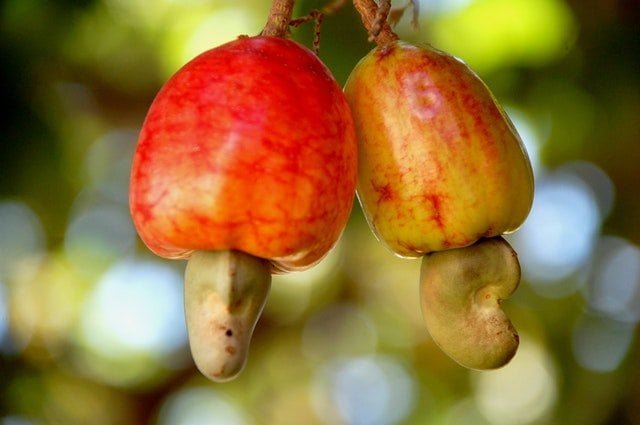This ultimate guide on cashew nut farming will help in cultivating cashew nut in your farm. Get to know plantation method, fertilizers, irrigation, etc. Cashew is the third commercially important nut crop in the international trade.
According to an economical analysis, a cashew nut plant operating with full capacity can make profit of 1329 Indian Rupees per day. Therefore for farmers it is a great opportunity to earn good amount of profit by cultivating Cashew nut in their farm.
Table of Contents
Introduction
Cashew nut or Anacardium occidentale is an evergreen small tropical tree that belongs to Anacardiaceae family. The dwarf variety can grow up to 6 metres but the tall variety can grow up to 14 metres. However dwarf varieties are more profitable as they give higher yields.
Mainly nuts are of economical value but you can also harvest other parts such as shells, leaves, sap from bark, etc. Leaves yield tan, shells yield cashew nut oil, and sap from bark yield indelible ink.
Origin Of Cashew
Researchers believe that cashew originated in Brazil. They are native to north eastern Brazil. But it is widely cultivated in tropical regions like India and East India.
Area & Production
The total area of land used for cashew farming is estimated around 3,953,175 hectares in the year 2007(FAO). You will be surprised to know that it has increased by 665% from 1961.
Worldwide cashew farmers produced around 3.96 Million metric tonnes of in shell basis cashew nuts in the year 2019. According to nationmaster.com, Vietnam is the largest producer of Cashew nuts in the world.
Farmers in Vietnam produced around 2,598,220 tonnes of cashew nuts in the year 2019. This is followed by India, Ivory Coast, Philippines, Benin, Tanzania, etc. Total cashew nut production in India is estimated around 786,326 tonnes in 2019.
Cashew Nut Farming Guide

Climate & Temperature
Cashew crop can tolerate wide range of ecological factors. You can cultivate cashew in altitude below 700 metres where temperature does not fall below 20o Celsius.
However, for best results, cultivating in altitude below 400 metres with atleast 9 hours of sunlight daily from December to May is ideal.
Cashew is a hardy and draught resistant crop therefore it can adopt very well to dry climatic conditions. Although Cashew plant likes warm climate, but temperature above 36o Celsius can affect fruit setting and retention.
Soil
Another important factor you need to know before cultivating cashew is soil requirement. Cashew is very sensitive to water logging, therefore avoid cultivating them in heavy clay soil with poor drainage conditions.
Moreover also avoid cultivating them in excessive saline and alkaline soils. Cashew crop perform very well in red sandy loams, laterite soil and coastal sands. You can also grow them on well drained black soil or in hill slopes on organic rich soil.
They like slightly acidic soil pH and pH more that 8 is not suitable.
Propagation
You can propagate cashew by Layering, Budding, and Grafting. Practice air layering in cashew during February to March for plantation in June to July. Similarly you can also practice patch budding during March to June for propagating cashew.
To learn more about propagation methods in detail, you can connect with us on Facebook or Instagram.
Field Preparation
Soil depth, slope, stoniness, soil fertility and water availability affect very little because cashew is a hardy crop. For cashew plantation you can start field preparation with the onset of pre-monsoon showers. Prepare pits of 60×60×60 centimetres at spacing of 8×8 metres for plantation.
By following this spacing you will be able to plant about 175 plants per hectare. Keep the pits exposed under sunlight for 15 days before plantation of cashew.
Fill these pits with a mixture made by adding soil + 5 Kg organic compost + 2 Kg poultry manure + 200 gm rock phosphate. You should avoid waterlogging condition in the field. For this purpose prepare small drainage channel to remove excess water.
Start plantation during July to August and plant 5 to 12 months old grafts for best results. If you are cultivating cashew in sloppy lands then terracing around plants are highly essential to control erosion.

Fertilizers
For better growth apply 10 to 15 Kilograms of Farm Yard Manure per plant. In a year you should give 500 grams nitrogen, 125 grams P2O5(Phosphorus), and K2O(Potassium) per plant. Immediately after cessation of rains you can apply fertilizers for ideal results.
However you can also apply fertilizer in two split dozes, first half during pre-monsoon and second half during post-monsoon period.
Irrigation
You can easily cultivate cashew under rainfed conditions. However during seedling stage in summer cashew crop requires irrigation. You can give 200 litres of water per plant at 15 day intervals from February to March to double the yield.
Avoid water logging condition in the field for better growth of plants.
Pests & Diseases
Pests such as Leaf and blossom webber, leaf miner, tea mosquito bug, stem and root borers can damage your cashew crop. For successful control follow these guidelines:
| Pests | Control Methods |
|---|---|
| Leaf and blossom webber | Spray 0.05% Endosulphan or carbaryl. |
| Leaf miner | Spray 0.05% Quinalphos. |
| Tea mosquito bug | Spray 0.05% Quinalphos. |
| Stem and Root borers | Remove affected bark and grubs, apply 10 grams phorate granules per plant. |
| Apple and Nut borers | Spray Malathion or 0.15% Carbaryl. |
Diseases such as damping off, die back, inflorescence blight, and anthracnose can also damage cashew crop. For controlling them you can follow these measures:
| Diseases | Control Methods |
|---|---|
| Damping off | Drench soil with 1% Bordeaux mixture. |
| Die Back | Prune the affected parts, and apply 1% Bordeaux paste. |
| Inflorescence Blight | Spray 0.05% Endosulphan. |
| Anthracnose | Spray 1% Bordeaux mixture. |
Harvesting
You can start harvesting cashew 3 years after plantation. You will start getting complete yield from 10th year after plantation. However this will continue till 20th year. Start harvesting fully matured nuts from February to May.
Before storing the nuts, sun dry them for 3 days.
Yield
On an average you will get 2 kilograms of nuts per plant ( 3-5 years plant age). Thereafter 4 Kilograms at 6 to 10 years and 5-10 Kilograms at 11 to 20 years.
Author’s Note
I hope you have understood the process of cashew farming from this guide. If you have any ideas, queries, or suggestions then please comment below. You can also connect with Agriculture Review on Facebook, Instagram, and Koo.





